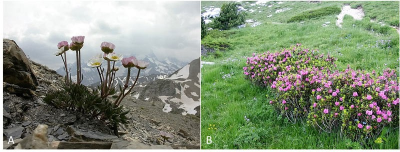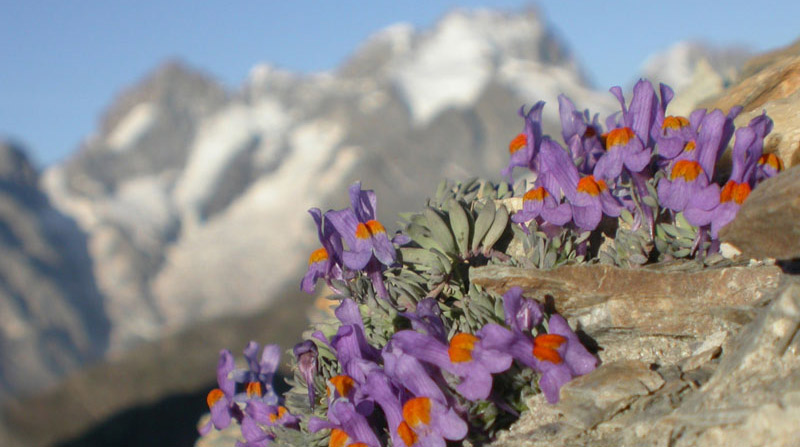高山植物的繁殖策略

在恶劣的自然环境条件下或者处于类似于高山这种特殊环境中,植物必须适应其所处的环境以确保繁衍后代。植物主要采取两种策略,一代又一代坚守在这里:维持有性生殖或者采用营养生殖。本文以几个适应高山环境的植物为例来展示它们繁殖策略的多样性。
“高山”环境是指地球上所有海拔超过自然林线、人类干扰很少的地方,它们分布在阿尔卑斯山、安第斯山脉、喜马拉雅山、新西兰……。在这些寒冷的环境里的主要特点是生长季非常短暂,适合种子生存的地点很少,且由于传粉昆虫稀少、盛行强风、气候年际变化大,导致授粉困难。
高山植主要物通过两种策略,一代又一代坚守在这里:保持有性生殖的方式或者采取营养生殖的方式。
1. 有性生殖
有性生殖是动植物应对环境波动所需的遗传多样性的来源之一。植物的有性生殖包括开花、传粉、种子的形成与散布、萌发等多个阶段,在高山环境中每个阶段都危机四伏,植物可以采取多种策略克服高山环境的限制。
1.1.长寿命
高山植物区系中一年生植物(完成其生命周期需要一年时间的植物)所占比例不足 2%[1](图 1),一年生植物完全依赖于有性生殖,因而也受制于自然环境。即使能即使产生种子,它们也需要新的萌发地点,但由于基岩(岩石区域、碎石坡)和其他物种的存在,这些地点通常是有限的。相反,多年生植物有时间等待有利于繁殖的条件(图 2)。但在干旱和地中海高山群落生境(具有相对均匀确定的物理和化学特征的生存场所。这个环境是一组生命形式的栖息地,包括植物群、动物群、微生物群。生物群落和它所支持的生物群形成一个生态系统。)中,一年生植物分布更为广泛[2],在这里种子代表着一种抗性。


1.2.几年扩散繁殖期

有一些植物的扩散种子成熟期跨越几年时间,也有一些植物在开花的前一年先形成花序,这样可以保证一旦环境条件满足开花的要求就可以立即开花。例如冰川毛茛(图 3),这个物种打破了阿尔卑斯山的海拔记录(分布在海拔超过 4000米 的瑞士境内),又如高山玫瑰杜鹃(图 3),它们在秋季形成大量花蕾,包含所有花朵,春天雪一融化就能开花。
1.3. 延长开花期

在山地物种中,开花期和花期持续时间随着海拔的增加而延长,这可以弥补传粉媒介的相对稀缺。例如, 生长在安第斯山脉海拔 2200-3500米 的一年生植物Chaetanthera pusilla(图 4)会产生很多花序(在同一基部上聚集花朵),上面的花朵次第开放。同时,花序上的每一朵花能接受外来花粉(描述了一朵花或花序可能受到外部花粉受精的状态。)的时间高海拔地区是处低海拔地区的约 2 倍:2700 米 处约为 7.7 天,3500 米 处约为 13.4 天 [2]。
1.4. 运用颜色更艳丽?
据说海拔越高的地方花的颜色更鲜艳,以便更有效地吸引传粉者(图5)。事实上,花朵的色泽、大小或者与吸引昆虫相关的其他特征都没有随着海拔升高而更显著[3]。新西兰的山地就是一个典型的例子:绝大多数的植物的花朵都是白色的(图6)。


2. 征服领土:营养繁殖
为了避免依赖有性生殖的风险,许多高山植物采取营养繁殖(植物生物体在无需性繁殖的情况下繁殖的方式。这种方式产生具有相同基因组的新个体,因此它们是克隆体,也称为克隆繁殖。)的方式。营养繁殖不是山地植物特有的繁殖方式,但是随着海拔升高采用营养繁殖的植物比例增加[1]。所有的营养生殖模式都存在高山植物中可以找到所有营养繁殖的类型:产生根状茎(一个地下的茎,带有叶芽和根芽。块茎可以是水平的,或多或少接近地表,比如鸢尾花,也可以更深,比如旋花。)或匍匐茎(从植物主茎的基部蔓延出来的一种匍匐茎,带有叶芽和根芽,将成为一个新的植物。草莓就是这种情况,它通过地下芽的发育形成,草莓芽可以自然繁殖植株,使其以相同的方式进行繁殖。),形成密集的丛生状或根出条,或通过被埋压(这是指在埋藏的树枝上生长出根系,从而产生一个新个体的过程。)、胎生(这种繁殖方式指的是种子在仍然附着在母体植物上的果实内发芽的情况。) 或无融合生殖(这种无需受精就能产生与母本植物相同的种子的繁殖方式称为”无性繁殖”。无性繁殖通过孢子发育而非种子发育,因此新个体与母本植物基本相同。无性繁殖可以传递体细胞突变,即非生殖细胞中发生的突变,因此可以创造出多样性。)等方式繁殖。
2.1. 根状茎和匍匐茎

根状茎和匍匐茎能帮助植物开发利用周围的空间,例如在碎屑堆的石块间生存。如图 7 所示,一种路边青属植物利用匍匐茎进行克隆繁殖,使其到达碎屑堆上,并产生无性系分株(植物的天然或人工克隆体,通过插枝繁殖而成。见图 7),在石块间定植。一旦匍匐茎遭到破坏,它们就会与母株分离,形成独立的个体。
2.2. 根出条、丛生型、压条型

这些类型的营养繁殖使得植物能够占据密集的空间,对高山生态系统有两个重要的影响。:稳定陡峭的边坡土壤、形成适宜的温湿度微环境。纤毛风铃草就是一个典型例子,它通过根出条形成了一丛丛生长缓慢的紧凑植株(图8)。

弯叶莎草(图 8)是一种典型的丛生植物,它是很多欧洲温带山区草地的优势种。最近的研究采用基因分型技术(实验室技术,比如全基因组测序,用于分类和比较基因序列。见“DNA 条形码” 一文)证实同一克隆上各个分株间基因型是相似的。弯叶莎草克隆平均每年增长0.4 毫米,由此推算,一个拥有 7000 个分株的克隆年龄约为 2000 年[4]!
关于压条型营养繁殖,如图 9 所示,百里香叶柳,其枝条与土壤接触处会生根。高山玫瑰杜鹃(杜鹃花属)或百里香叶柳等矮灌丛往往有由多个基株(遗传学上的个体)组成, 每个基株包括几十个分株,形成了一个难以穿透的冠层,只有通过基因型分析才能区分每个基株。
2.3. 胎生
胎生,例如通过在母本植物上开始发育的鳞茎芽的产生,以及无性生殖确保了更远距离的散布。如图 10 所示,廖科植物珠芽蓼的同一个花序上同时存在有性繁殖的花和无性繁殖产生的珠芽。由于花梗的长度恒定,珠芽部分所占比例随着海拔和纬度的增加而增加,也就是说,无性繁殖的重要性随着环境的恶劣程度增加而增大[1]。

3. 植物如何适应环境变化?
高山植物通过多种繁殖方式适应环境,多样的繁殖方式也是维持高山环境稳定和遗传多样性的有效机制。这种遗传多样性可能给高山植物提供了机会。目前高山植物区系正面临着严峻的气候变化,预计到本世纪内高山地区气温将上升 2-8 ℃,升温速度超过地质历史时期冰川、间冰期交替时温度波动的速度。温度的升高将促使植被带向上迁移,使适宜高山植物区系的环境萎缩。
参考文献和注释
封面图片. 从劳塔雷特高山植物园(Lautaret Alpine Garden)看到的梅格(Meige)群山[来源:图片由©约瑟夫-傅里叶高山站/谢尔盖-奥博特惠赐]
[1] Körner C (1999) Alpine plant life, Functional plant ecology of high mountain ecosystems. Springer-Verlag Publishing
[2] Arroyo MTK et al (1998) The flora of Llullaillaco National Park located in the transitional winter-summer rainfall area of the northern Chilean Andes. Gayana Botanica 55:93-110
[3] Totland Ø et al (2005) Abstract No. 13.10.2. 17th International Botanical Congress, Vienna
[4] Steinger T, Körner C & Schmid B (1996) Long-term persistence in a changing climate: DNA analysis suggests very old ages of clones of alpine Carex curvula. Oecologia 105:307-324
环境百科全书由环境和能源百科全书协会出版 (www.a3e.fr),该协会与格勒诺布尔阿尔卑斯大学和格勒诺布尔INP有合同关系,并由法国科学院赞助。
引用这篇文章: TILL-BOTTRAUD Irène, AUBERT† Serge, DOUZET Rolland (2024年3月14日), 高山植物的繁殖策略, 环境百科全书,咨询于 2025年4月8日 [在线ISSN 2555-0950]网址: https://www.encyclopedie-environnement.org/zh/vivant-zh/reproductive-strategies-of-alpine-plants/.
环境百科全书中的文章是根据知识共享BY-NC-SA许可条款提供的,该许可授权复制的条件是:引用来源,不作商业使用,共享相同的初始条件,并且在每次重复使用或分发时复制知识共享BY-NC-SA许可声明。








